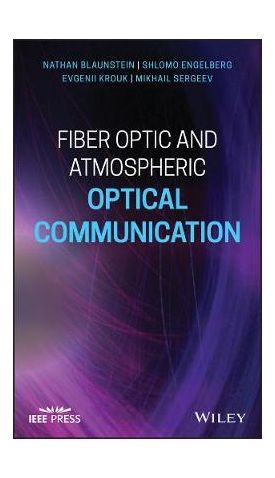אנו משתמשים ב-Cookies כדי לשפר את החוויה שלך. כדי לקיים ההנחיה החדשה של e-Privacy, עלינו לבקש את הסכמתך להגדיר את ה-Cookies. קבלת מידע נוסף.
808.00 ₪
Fiber Optic and Atmospheric Optical Communication
808.00 ₪
ISBN13
9781119601999
יצא לאור ב
Hoboken
זמן אספקה
21 ימי עסקים
עמודים
300
פורמט
Hardback
תאריך יציאה לאור
23 בינו׳ 2020
שם סדרה
Wiley - IEEE
This book answers the fundamental question of how to characterize and overcome the drawbacks associated with optical communication links that suffer from various types of fading when optical signals with information traverse these wireless (atmospheric) or wired (fiber optic) channels. The authors present material to help the reader predict the capacity, data rate, spectral efficiency, and bit-error-rate (BER) associated with a channel that experiences fading. It also presents modulation techniques and methods of coding and decoding that are useful when implementing communications systems. The book discusses how to model the channels, including treating distortion due to the various fading phenomena. Light waves and their similarity to radio waves are described, and the way light propagates through the atmosphere, through materials, and through the boundary between two materials is explained. This book also presents modulation techniques and methods of coding and decoding that are useful when implementing communications systems.
| עמודים | 300 |
|---|---|
| פורמט | Hardback |
| ISBN10 | 1119601991 |
| יצא לאור ב | Hoboken |
| תאריך יציאה לאור | 23 בינו׳ 2020 |
| תוכן עניינים | Part I: Optical Communication Links Fundamentals Chapter 1: Basic Elements of Optical Communication 1.1 Spectrum of Optical Waves 1.2 Optical Communication in Historical Perspective 1.3 Optical Communication Link Presentation Bibliography Chapter 2: Optical Wave Propagation 2.1 Similarity of Optical and Radio Waves 2.2 Electromagnetic Aspects of Optical Waves Propagation 2.3 Propagation of Optical Waves in Free Space 2.4 Propagation of Optical Waves through the Boundary of Two Media 2.4.1 Boundary conditions 2.4.2 Main formulations of reflection and refraction coefficients 2.5 Total Intrinsic Reflection in Optics 2.6 Propagation of Optical Waves in Material Media Problems Bibliography Part II: Fundamentals to Optical Communication Chapter 3: Types of Signals in Optical Communication Channels 3.1 Types of Optical Signals 3.2 Mathematical Description of Narrowband Signals 3.3 Mathematical Description of Wideband Signals Bibliography Chapter 4: Main Principles of Discrete Signals Coding and Decoding 4.1 Basic concepts of Coding and decoding 4.1.1 General connection scheme 4.1.2 The binary symmetric channel (BSC) 4.1.3 Channel model with AWGN 4.2 Basic Aspects of Coding and Decoding 4.2.1 Criteria of coding 4.2.2 Code parameters for error correction 4.2.3 Linear codes 4.2.4 Estimation of error probability of decoding 4.3 Codes with Algebraic Decoding 4.3.1 Cyclic codes 4.3.2 BCH codes 4.3.3 Reed-Solomon codes 4.4 Decoding of Cyclic Codes Bibliography Chapter 5: Coding in Optical Communication Channels 5.1 Peculiarities of Cyclic Codes in Communication Systems 5.2 Codes with Low Density of Parity Checks 5.2.1 Basic definitions 5.2.2 Decoding of LDPC-codes 5.2.3 Construction of the irregular LDPC codes 5.2.4 Construction of the regular LDPC-codes 5.3 Methods of Combining Codes 5.4 Coding in Optical Channels Bibliography Chapter 6: Fading in Optical Communication Channels 6.1 Parameters of Fading in Optical Communication Channel 6.1.1 Time dispersion parameters 6.1.2 Coherence bandwidth 6.1.3 Doppler spread and coherence time 6.2 Types of Small-Scale Fading 6.2.1 Narrowband optical links with fading 6.2.2 Wideband optical links with fading 6.3 Mathematical Description of Fast Fading 6.4 Mathematical Description of Large-Scale Fading Bibliography Chapter 7: Modulation of Signals in Optical Communication Links 7.1. Analogue Modulation 7.1.1 Analog amplitude modulation 7.1.2 Analog angle modulation - frequency and phase 7.1.3 Spectra and bandwidth of FM or PM signals 7.1.4 Relations between SNR and bandwidth in AM and FM signals 7.2 Digital Signal Modulation 7.2.1 Main parameters of digital modulation 7.2.2 Linear digital modulation 7.2.3 Non-linear digital modulation Problems Bibliography Chapter 8: Optical Sources and Detectors 8.1 Emission and Absorption of Optical Waves 8.2 Operational Characteristics of Laser 8.3 Light-Emitted Sources and Detectors 8.3.1 Light-emitted p-n type diode 8.3.2 Laser p-n type diode 8.3.3 Photodiode 8.3.4 PiN and p-n photodiodes - principle of operation 8.4 Operational Characteristics of Light Diodes Bibliography Part III: Wired Optical Communication Links Chapter 9: Light Waves in Fiber Optic Guiding Structures 9.1. Propagation of Light in Fiber Optic Structures 9.1.1 Types of optical fibers 9.1.2 Propagation of optical wave inside the fiber-optic structure Bibliography Chapter 10: Dispersion Properties of Fiber Optic Structures 10.1 Characteristic parameters of fiber optic structures 10.2 Dispersion of optical signal in fiber optic structures Bibliography Part IV: Wireless Optical Channels Chapter 11: Atmospheric Communication Channels 11.1 Basic Characteristics of Atmospheric Channel 11.2 Effects of Aerosols on Atmospheric Communication Links 11.3 Effects of Hydrometeors 11.3.1 Effects of Fog 11.3.2 Effects of Rain 11.3.3. Effects of Clouds 11.4 Effects of Turbulent Gaseous Structures on Optical Waves Propagation 11.4.1 Turbulence Phenomenon 11.4.2 Scintillation Phenomenon of Optical Wave passing the Turbulent Atmosphere 11.4.3 Effects of Atmosphere Turbulences on Signal Fading 11.5 Optical Waves Propagation Caused by Atmospheric Scattering Bibliography Part V: Parameters of Signals in Atmospheric and Fiber Optic Communication Links Chapter 12: Transmission of Information Data in Optical Channels: Atmospheric and Fiber Optics 12.1 Characteristics of Information Signal Data in Optical Communication Links 12.2 Bit-Error-Rate of Optical Communication Channel 12.3 Relations between Signal Data Parameters and Fading Parameters in Atmospheric Links 12.4 Effects of Fading in Fiber Optic Communication Link Bibliography Abbreviations Symbols |
| זמן אספקה | 21 ימי עסקים |



Login and Registration Form